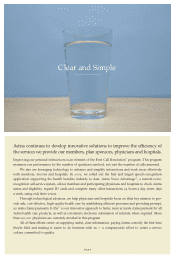Aetna 2002 Annual Report Download - page 21
Download and view the complete annual report
Please find page 21 of the 2002 Aetna annual report below. You can navigate through the pages in the report by either clicking on the pages listed below, or by using the keyword search tool below to find specific information within the annual report.
. , .. (-)
Majority Leader
United States Senate
We’ve seen stunning payoffs from federal investments in research.
That commitment must not wane.
When I was elected to the United States Senate in after two decades in academic medicine,
the annual budget for the National Institutes of Health (NIH) was just over $ billion. Since
then, the NIH budget has more than doubled — growing over times faster than the
overall federal budget to top $ billion this year.
There have been stunning practical payoffs from increased federal research investments
during the past decade. We have dramatically improved treatments for people living with the
HIV infection and helped eradicate or reduce the incidence of diseases such as smallpox,
hepatitis B, measles and polio. Federal research has played an important role in the remarkable
decline in cardiovascular illness, and promises even greater advances through the Human
Genome Project that has revolutionized the understanding of the basic building blocks of life.
During the next few years, competing domestic and international priorities— coupled
with the return of federal deficits — will make it difficult to expand government research
investments as dramatically. Yet the commitment must not wane, for the challenges remain.
The aging of the baby boom population will place unprecedented demands on the U.S.
health care system. The threat of infectious disease continues through the re-emergence of
tuberculosis and malaria and the increasing prevalence of HIV and AIDS. The United States
faces health disparities linked to income, race, lack of health insurance coverage and gaps in
the current safety net. The growing threat of bioterrorism will require improved surveillance
systems, a stronger public health infrastructure, and better vaccines and treatments.
Today’s challenges require a substantially improved ability to translate scientific knowledge
and technological capability into daily medical practice.
T o accomplish this, we must develop better processes for establishing research priorities
based on scientific data and health analysis, moving beyond input measures and anecdotes to
develop new metrics to measure scientific advances and their causal relationship to improved
health outcomes. We must also improve collaboration across government agencies, between
the public and private sectors, and among scientific disciplines.
Finally, to translate new discoveries into practice, we must take steps to modernize and
improve government health-financing programs, expand access to care to the millions of
Americans without health coverage, reduce health disparities, and help physicians and other
practitioners assimilate burgeoning advances to reduce medical errors and improve health care
quality. Along with the continued need to fund research, policy-makers, the scientific and
medical communities, and the public must together refine and improve the nation’s scientific
framework and improve the ability to translate research advancements into patient care.
Federal Funding for Biomedical Research:
Commitment and Benefits
























